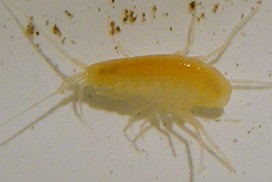Anconodon is an extinct genus of mammal from the Paleocene of North America, and thus lived just after the "age of the dinosaurs". It was a member of the extinct order Multituberculata within the suborder Cimolodonta and possibly the family Cimolodontidae.
Crangonyx dearolfi, also known as the Pennsylvania cave amphipod or Pennsylvania cave crangonyctid, is a species of crustacean in family Crangonyctidae. It is native to the United States, where it is found in caves in Pennsylvania and Maryland.
Stygobromus araeus, the Tidewater interstitial amphipod, is a phreatobite species of amphipod in family Crangonyctidae. It is native to Virginia and North Carolina in the United States.

Stygobromus is a genus of amphipod crustaceans that live in subterranean habitats. As well as a large number of species in North America, a smaller number of species are also known from Eurasia. Most of the North American species live in areas which were not covered by the Laurentide Ice Sheet, although a few species seem to have survived under the ice. A number of species are on the IUCN Red List as endangered species (EN) or vulnerable species (VU); all the listed species are endemic to the United States. One species, S. lucifugus, is extinct. Stygobromus includes the following species:
Stygobromus arizonensis, the Arizona cave amphipod, is a troglomorphic species of amphipod in family Crangonyctidae. It is endemic to Arizona in the United States.
Stygobromus balconis, the Balcones cave amphipod, is a troglomorphic species of amphipod in family Crangonyctidae. It is endemic to Texas in the United States.
Stygobromus barri, commonly called Barr's cave amphipod, is a troglomorphic species of amphipod in family Crangonyctidae. It is endemic to Missouri in the United States.
Stygobromus bifurcatus, the bifurcated cave amphipod, is a troglomorphic species of amphipod in family Crangonyctidae. It is endemic to Texas in the United States.
Stygobromus hayi is a rare species of crustacean known by the common name Hay's spring amphipod. It is endemic to the District of Columbia in the United States, where it occurs only in Rock Creek, a tributary of the Potomac River. It is a federally listed endangered species, is listed as Endangered on the IUCN Red List, and as Critically Imperiled by NatureServe.
Stygobromus indentatus is a species of crustacean in family Crangonyctidae. It is endemic to the United States. Its natural habitat is inland karsts.
Stygobromus lucifugus, the rubious cave amphipod is an extinct species of amphipod crustacean in the family Crangonyctidae. It was first described by Oliver Perry Hay who found it living in a well near Abingdon, Knox County, Illinois, United States, and it was endemic to that state.

Stygobromus pecki, the Peck's cave amphipod, is a rare species of crustacean found in four cavern areas of southwestern Texas in the United States. It is a federally listed endangered species in the United States and is also listed as Endangered on the IUCN Red List. Because of the species' limited geographical distribution, not much information on S. pecki is known. As of April 2022, there is no available 5-year review, Species Status Assessment, or recovery plan for the species. However, the Edwards' Aquifer Habitat Conservation Program (EAHCP), with the support of the U.S. Fish and Wildlife Service (UFWS), has been attempting to further study and promote conservation of S. pecki.
Stygobromus smithi, the Alabama well amphipod, is a species of crustacean in family Crangonyctidae. It is endemic to the United States.

Stygobromus kenki is a rare species of amphipod, a crustacean. Its common names include Kenk's amphipod, Rock Creek groundwater amphipod, and Rock Creek stygobromid.
Crangonyx gracilis, the northern lake crangonyctid, is a species of amphipod in the family Crangonyctidae. It is found in North America.
David A. Hubbard, Jr is an American speleobiologist and karst geologist, exploring and documenting speological sites and life forms around Virginia and Maryland. He has published on phenomenon of burial caves, in particular by the indigenous peoples of Virginia, as well as the use of caves by human beings over the past 10,500 years.


